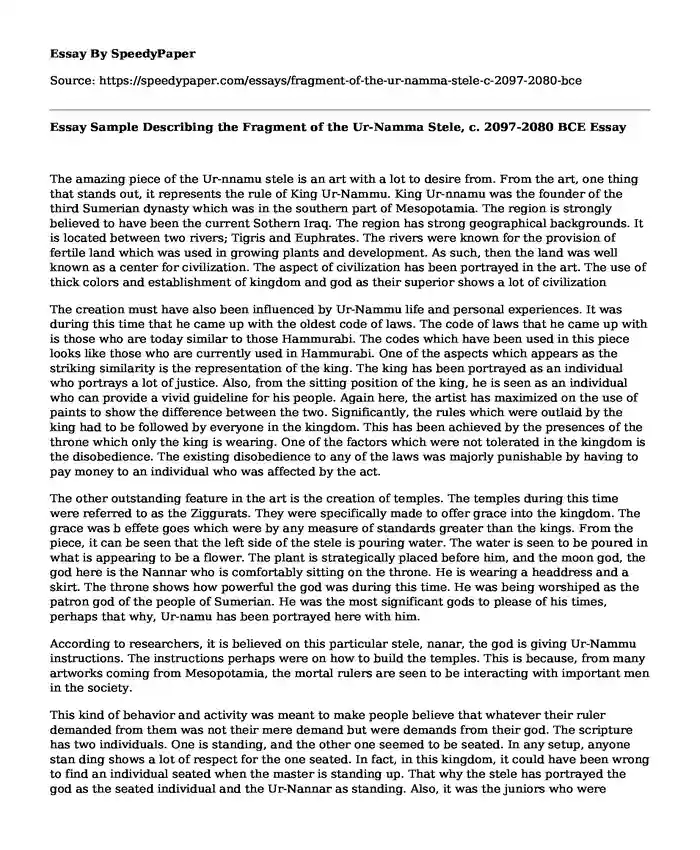The amazing piece of the Ur-nnamu stele is an art with a lot to desire from. From the art, one thing that stands out, it represents the rule of King Ur-Nammu. King Ur-nnamu was the founder of the third Sumerian dynasty which was in the southern part of Mesopotamia. The region is strongly believed to have been the current Sothern Iraq. The region has strong geographical backgrounds. It is located between two rivers; Tigris and Euphrates. The rivers were known for the provision of fertile land which was used in growing plants and development. As such, then the land was well known as a center for civilization. The aspect of civilization has been portrayed in the art. The use of thick colors and establishment of kingdom and god as their superior shows a lot of civilization
The creation must have also been influenced by Ur-Nammu life and personal experiences. It was during this time that he came up with the oldest code of laws. The code of laws that he came up with is those who are today similar to those Hammurabi. The codes which have been used in this piece looks like those who are currently used in Hammurabi. One of the aspects which appears as the striking similarity is the representation of the king. The king has been portrayed as an individual who portrays a lot of justice. Also, from the sitting position of the king, he is seen as an individual who can provide a vivid guideline for his people. Again here, the artist has maximized on the use of paints to show the difference between the two. Significantly, the rules which were outlaid by the king had to be followed by everyone in the kingdom. This has been achieved by the presences of the throne which only the king is wearing. One of the factors which were not tolerated in the kingdom is the disobedience. The existing disobedience to any of the laws was majorly punishable by having to pay money to an individual who was affected by the act.
The other outstanding feature in the art is the creation of temples. The temples during this time were referred to as the Ziggurats. They were specifically made to offer grace into the kingdom. The grace was b effete goes which were by any measure of standards greater than the kings. From the piece, it can be seen that the left side of the stele is pouring water. The water is seen to be poured in what is appearing to be a flower. The plant is strategically placed before him, and the moon god, the god here is the Nannar who is comfortably sitting on the throne. He is wearing a headdress and a skirt. The throne shows how powerful the god was during this time. He was being worshiped as the patron god of the people of Sumerian. He was the most significant gods to please of his times, perhaps that why, Ur-namu has been portrayed here with him.
According to researchers, it is believed on this particular stele, nanar, the god is giving Ur-Nammu instructions. The instructions perhaps were on how to build the temples. This is because, from many artworks coming from Mesopotamia, the mortal rulers are seen to be interacting with important men in the society.
This kind of behavior and activity was meant to make people believe that whatever their ruler demanded from them was not their mere demand but were demands from their god. The scripture has two individuals. One is standing, and the other one seemed to be seated. In any setup, anyone stan ding shows a lot of respect for the one seated. In fact, in this kingdom, it could have been wrong to find an individual seated when the master is standing up. That why the stele has portrayed the god as the seated individual and the Ur-Nannar as standing. Also, it was the juniors who were supposed to be doing work inform of their masters. This has been portrayed in the stele by Ur-nonfarm pouring water into the flower. The presence of flower is used to illustrate the kind of beauty that marked where the ruler and god used to meet and leave. It also represents peace. The two were seen as a sign of peace in the society, and that's why the dentelle has flower between god and Ur-Nannar.
From the stele below they are people. There is a vivid separation between the junior and the seniors in this community. It also shows the vivid chain of command from the top authority to the local man. This an s pact also shows a lot of obedience which is shown to both god and king. In could only be assumed that these individuals were taught to believe that the disobedience to the king could automatically earn that they disobey their god.
Works Cited
Suter, Claudia E. "On Images, Visibility, and Agency of Early Mesopotamian Royal Women." The First Ninety Years: A Sumerian Celebration in Honor of Miguel Civil 12 (2017): 337.
Cite this page
Essay Sample Describing the Fragment of the Ur-Namma Stele, c. 2097-2080 BCE. (2022, Apr 25). Retrieved from https://speedypaper.com/essays/fragment-of-the-ur-namma-stele-c-2097-2080-bce
Request Removal
If you are the original author of this essay and no longer wish to have it published on the SpeedyPaper website, please click below to request its removal:
- Police Officer Cover Letter. Caree Essay Sample.
- Impacts of Immigration and Bill Clinton's Scandals in America
- Essay Sample: An Introduction to Islam
- Free Essay on Organization's Disaster Recovery Plan
- Essay Sample: Wage-Labor and Capital According to Karl Marx
- Illegal Aliens and crime
- Paper Example. Deaf Culture vs. Hearing Culture
Popular categories





